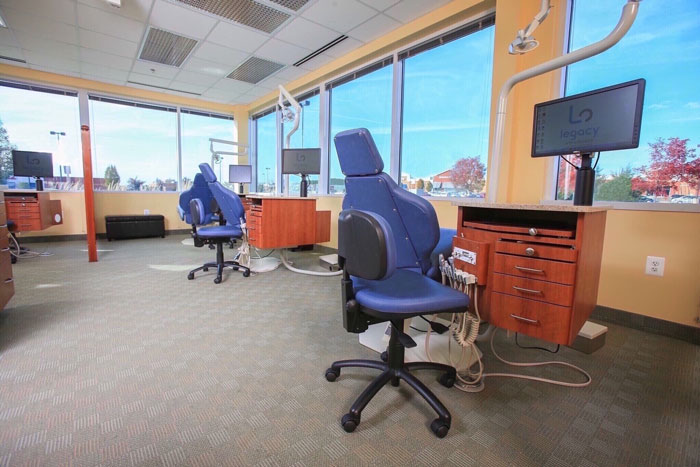Legacy Orthodontics - The Facts
Legacy Orthodontics - The Facts
Blog Article
Our Legacy Orthodontics Statements
Table of ContentsThe 4-Minute Rule for Legacy OrthodonticsLegacy Orthodontics Can Be Fun For AnyoneLegacy Orthodontics Can Be Fun For AnyoneThe smart Trick of Legacy Orthodontics That Nobody is Talking AboutLegacy Orthodontics for Beginners
In addition, we provide flexible treatment routines, flexible settlement choices and a fun, delightful experience.An orthodontist is a dental professional educated to identify, prevent, and treat teeth and jaw abnormalities. Orthodontists work with people of all ages, from kids to adults.
Malocclusion, or misaligned teeth, can cause oral issues, consisting of tooth decay, periodontal condition, and difficult or excruciating eating. Not every person is born with straight teeth. If you have a negative bite or huge rooms in between your teeth, you may desire to get in touch with a dental professional specializing in orthodontic care.
Our Legacy Orthodontics Ideas
( Image Credit Report: DigitalVision/Getty Images) Orthodontists utilize dealt with and removable dental gadgets, like dental braces, retainers, and bands, to transform the placement of teeth in your mouth. Orthodontic treatment is for dental abnormalities, including: Jagged teethBite issues, like an overbite or an underbiteCrowded teeth or teeth that are too far apartJaw misalignmentThe objective of orthodontic treatment is to improve your bite.
A healthy bite ensures you can consume, chew, and talk appropriately. While you may think of orthodontists as primarily for kids or young adults that require dental braces, they can deal with dental troubles at any kind of age. Orthodontists go to college, dental school, and orthodontic institution. After graduation, they spend 2 or 3 years in an orthodontic residency program.
, but not all dental practitioners are orthodontists. They concentrate on two areas: How to properly and securely relocate teeth Exactly how to correctly direct development in the teeth, jaw, and faceOnce an orthodontist has actually completed training, they have the option to become board licensed.
The Single Strategy To Use For Legacy Orthodontics
Imbalance, or malocclusion, is the most common factor individuals see an orthodontist. It is hereditary and is the result of dimension distinctions in between the top and lower jaw or in between the jaw and teeth. Malocclusion causes tooth overcrowding, a misshapen jaw, or uneven bite patterns. Malocclusion is generally treated with: Your orthodontist affixes metal, ceramic, or plastic square bonds to your teeth.
If you have just minor malocclusion, you might have the ability to use clear braces, called aligners, rather than typical braces (https://www.blogtalkradio.com/legacyortho). Some individuals need a headgear to help relocate teeth into line with pressure from outside the mouth. After braces or aligners, you'll need to use a retainer. A retainer is a personalized device that maintains your teeth in location.
They're most usually made use of on youngsters. They can produce added room in the mouth without having to draw teeth. If you have a severe underbite or overbite, you might need orthognathic surgical treatment (likewise called orthodontic surgical treatment) to extend or shorten your jaw. Orthodontists use cables, surgical screws, or plates to support your jaw bone.
You might require to see an orthodontist if you have: Crowding or not sufficient space for all of your teethOverbite, when your upper teeth come your base teethUnderbite, when your base teeth are as well much forwardSpacing or problems with gapsCrossbite, which is when your upper teeth fit behind your base teeth when your mouth is closedOpen bite or an upright space between your front base and upper teethMisplaced midline, when the facility of your base and top teeth do not align Fixing a dental malocclusion can: Make biting, chewing, and speaking easierImprove the symmetry of our face and your general appearanceEase pain from temporomandibular joint conditionsDifferent your teeth and make them less complicated to clean, aiding prevent tooth decay or dental caries It's typically a dental expert that first notifications misaligned teeth during a routine examination.
Legacy Orthodontics Fundamentals Explained

Throughout your very first orthodontic assessment, you'll likely have: An oral examPhotos taken of your face and smileDental X-raysPanoramic (360 level) X-rays of your face and headImpressions to develop mold and mildews of your teethThese tests will assist your orthodontist know how to proceed with your therapy. braces. An orthodontist is a dentist that's had training to treat your teeth and jaw
Orthodontists may perform surgery, exams,X-rays,and even more to aid you acquire a much more comfortable, healthier smile. An orthodontist is concentrated on your bite, so something like a cracked tooth would be taken care of by a dentist. Orthodontists are dentists but not all dentists are orthodontists. Orthodontists are concentrated on your bite, or the means your teeth fit together, and the straightness of your teeth.
Ever before wondered just how stars always appear to have completely straightened teeth? Orthodontists are oral experts that focus on correcting abnormalities in the teeth and jaws.
The Buzz on Legacy Orthodontics

, orthodontists have a varied toolkit at their disposal. These tried-and-true dental braces use a system of braces bonded to the teeth and connected by wires.
These detachable trays are custom-made to progressively shift the teeth's position. In cases of narrow jaws, palatal expanders can be made use of to create space for proper tooth positioning.
Report this page